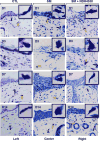Sulfur mustard induced mast cell degranulation in mouse skin is inhibited by a novel anti-inflammatory and anticholinergic bifunctional prodrug
- PMID: 29127031
- PMCID: PMC5938161
- DOI: 10.1016/j.toxlet.2017.11.005
Sulfur mustard induced mast cell degranulation in mouse skin is inhibited by a novel anti-inflammatory and anticholinergic bifunctional prodrug
Abstract
Sulfur mustard (SM, bis(2-chloroethyl sulfide) is a potent vesicating agent known to cause skin inflammation, necrosis and blistering. Evidence suggests that inflammatory cells and mediators that they generate are important in the pathogenic responses to SM. In the present studies we investigated the role of mast cells in SM-induced skin injury using a murine vapor cup exposure model. Mast cells, identified by toluidine blue staining, were localized in the dermis, adjacent to dermal appendages and at the dermal/epidermal junction. In control mice, 48-61% of mast cells were degranulated. SM exposure (1.4g/m3 in air for 6min) resulted in increased numbers of degranulated mast cells 1-14days post-exposure. Treatment of mice topically with an indomethacin choline bioisostere containing prodrug linked by an aromatic ester-carbonate that targets cyclooxygenases (COX) enzymes and acetylcholinesterase (1% in an ointment) 1-14days after SM reduced skin inflammation and injury and enhanced tissue repair. This was associated with a decrease in mast cell degranulation from 90% to 49% 1-3days post SM, and from 84% to 44% 7-14days post SM. These data suggest that reduced inflammation and injury in response to the bifunctional indomethacin prodrug may be due, at least in part, to abrogating mast cell degranulation. The use of inhibitors of mast cell degranulation may be an effective strategy for mitigating skin injury induced by SM.
Keywords: Acetylcholinesterase; Countermeasures; Epidermis; Mast cells; Sulfur mustard.
Copyright © 2017 Elsevier B.V. All rights reserved.
Figures



Similar articles
-
Mitigation of nitrogen mustard mediated skin injury by a novel indomethacin bifunctional prodrug.Exp Mol Pathol. 2016 Jun;100(3):522-31. doi: 10.1016/j.yexmp.2016.05.008. Epub 2016 May 14. Exp Mol Pathol. 2016. PMID: 27189522 Free PMC article.
-
Therapeutic potential of a non-steroidal bifunctional anti-inflammatory and anti-cholinergic agent against skin injury induced by sulfur mustard.Toxicol Appl Pharmacol. 2014 Oct 15;280(2):236-44. doi: 10.1016/j.taap.2014.07.016. Epub 2014 Aug 13. Toxicol Appl Pharmacol. 2014. PMID: 25127551 Free PMC article.
-
Structural changes in the skin of hairless mice following exposure to sulfur mustard correlate with inflammation and DNA damage.Exp Mol Pathol. 2011 Oct;91(2):515-27. doi: 10.1016/j.yexmp.2011.05.010. Epub 2011 Jun 13. Exp Mol Pathol. 2011. PMID: 21672537 Free PMC article.
-
Tissue injury and repair following cutaneous exposure of mice to sulfur mustard.Ann N Y Acad Sci. 2016 Aug;1378(1):118-123. doi: 10.1111/nyas.13125. Epub 2016 Jul 2. Ann N Y Acad Sci. 2016. PMID: 27371823 Free PMC article. Review.
-
Multi-inhibitor prodrug constructs for simultaneous delivery of anti-inflammatory agents to mustard-induced skin injury.Ann N Y Acad Sci. 2016 Aug;1378(1):174-179. doi: 10.1111/nyas.13177. Epub 2016 Aug 9. Ann N Y Acad Sci. 2016. PMID: 27505078 Free PMC article. Review.
Cited by
-
CDK4/6 inhibitor palbociclib suppresses IgE-mediated mast cell activation.J Transl Med. 2019 Aug 20;17(1):276. doi: 10.1186/s12967-019-2026-9. J Transl Med. 2019. PMID: 31429774 Free PMC article.
-
Increased Mast Cell Activation in Mongolian Gerbils Infected by Hepatitis E Virus.Front Microbiol. 2018 Oct 2;9:2226. doi: 10.3389/fmicb.2018.02226. eCollection 2018. Front Microbiol. 2018. PMID: 30333798 Free PMC article.
-
Inhibition of c-Fos expression attenuates IgE-mediated mast cell activation and allergic inflammation by counteracting an inhibitory AP1/Egr1/IL-4 axis.J Transl Med. 2021 Jun 15;19(1):261. doi: 10.1186/s12967-021-02932-0. J Transl Med. 2021. PMID: 34130714 Free PMC article.
-
Mast Cells Promote Nitrogen Mustard-Mediated Toxicity in the Lung Associated With Proinflammatory Cytokine and Bioactive Lipid Mediator Production.Toxicol Sci. 2021 Oct 27;184(1):127-141. doi: 10.1093/toxsci/kfab107. Toxicol Sci. 2021. PMID: 34453837 Free PMC article.
-
Soluble antigen arrays provide increased efficacy and safety over free peptides for tolerogenic immunotherapy.Front Immunol. 2024 Jun 12;15:1258369. doi: 10.3389/fimmu.2024.1258369. eCollection 2024. Front Immunol. 2024. PMID: 38933266 Free PMC article.
References
-
- Amitai G, et al. Bifunctional compounds eliciting anti-inflammatory and anti-cholinesterase activity as potential treatment of nerve and blister chemical agents poisoning. J Appl Toxicol. 2006;26(1):81–87. - PubMed
-
- Cardamone C, et al. Mast cells as effector cells of innate immunity and regulators of adaptive immunity. Immunol Lett. 2016;178:10–14. - PubMed
-
- Conti P, et al. Mast cell, pro-inflammatory and anti-inflammatory: Jekyll and Hyde, the story continues. J Biol Regul Homeost Agents. 2017;31(2):263–267. - PubMed
MeSH terms
Substances
Grants and funding
LinkOut - more resources
Full Text Sources
Other Literature Sources
Medical
Miscellaneous

